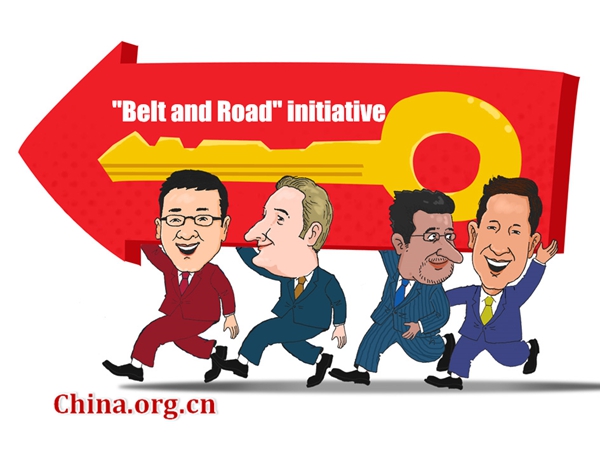Belt and Road
Your Present Location: PROGRAMS> Belt and Road`Belt and Road` initiative should also respond to cultural demands
Source: China.org.cn Published: 2016-5-11

In the same direction [By Zhai Haijun / China.org.cn]
The international community has started to get familiar with the "Belt and Road" initiative -- The Silk Road Economic Belt and Maritime Silk Road -- as projects have been launched one after another along the routes in recent years.
However, despite the international buzzword, few countries are better understanding the meaning and trends that the phrase stands for.
In my opinion, there are two different aspects for implementing this initiative. One is to define the "pain points" that drive the interconnectivity between countries along the "Belt and Road" routes to create a community of shared interests, and the other is to showcase diversified cultures and civilizations and to create a community of shared duties and future.
"Pain points" in economics are the points for profit on market and points of institution and system for improvement. The "Belt and Road" initiative can help countries along its routes, including China, upgrade industrial structures, improve foreign trade, encourage round trips of the transport facilities running between China and Europe in a bid to reduce the costs resulted from empty seats in single trips, ameliorate the qualification of Chinese enterprises which have obtained sufficient grounds in less developed countries, but occupied few footholds in the high-end markets, and develop competitive cultural products.
To address these pain points requires a five-way holistic approach, namely the communication of policies, the connection of transport, the smooth operation of trade, the free circulation of currencies and the connection of the minds and hearts of the people along the routes.
To truly understand our partners, we need to know their differentiated demands. For example, to well cooperate with Tajikistan and Kyrgyzstan, the Chinese government and enterprises should focus on joint development of their abundant water and tourist resources so as to benefit the local public.
In the middle and long run, the "go out" strategy should encourage more businesses, including catering, folk arts, cultural industry, education and Traditional Chinese Medicine (TCM), to engage peoples in the Silk Road countries in addition to the enormous infrastructural constructions such as high-speed railways, ports and nuclear power stations.
Although many Chinese researchers have studied the "Belt and Road" initiative out of political and economic perspectives, I have been more interested in taking it as a typical example of cultural economics. Ideally, it should yield both economic and cultural returns. Its popularity comes not only from it being an economic undertaking involving the interests of participating countries but also from it being a cultural endeavor which could get ready response from the people in related countries.
Amid the central-peripheral relations based on the political and economic paradigms framed by developed countries to regulate global orders, the countries taking a central part in the global system have eaten up the interests of peripheral countries by means of industrial chains through which the less developed countries have to attach to the major powers by exporting natural resources and preliminary products while the developed countries keep a firm grip of their advanced technology and industries.
Currently, refugees fleeing to the borders of European countries have proved that the peripheral peoples can threaten the national security of the countries staying at the central part of the world.
On the contrary, the "Belt and Road" initiative has centered on equality and inclusiveness as the words "road," "belt," "corridor" and "bridge" in Chinese refer to the connection of equal relations.
Based on the perspective of cultural economics, the "Belt and Road" initiative calls for people from different countries to communicate with their heart, so as to create an environment of mutual appreciation, understanding and reverence. The exchange of cultures can possibly result in huge enthusiasm among the peoples and countries in better and broader cooperation.
Key Words: Belt and Road; cultural;























































































 京公网安备 11010802037854号
京公网安备 11010802037854号





